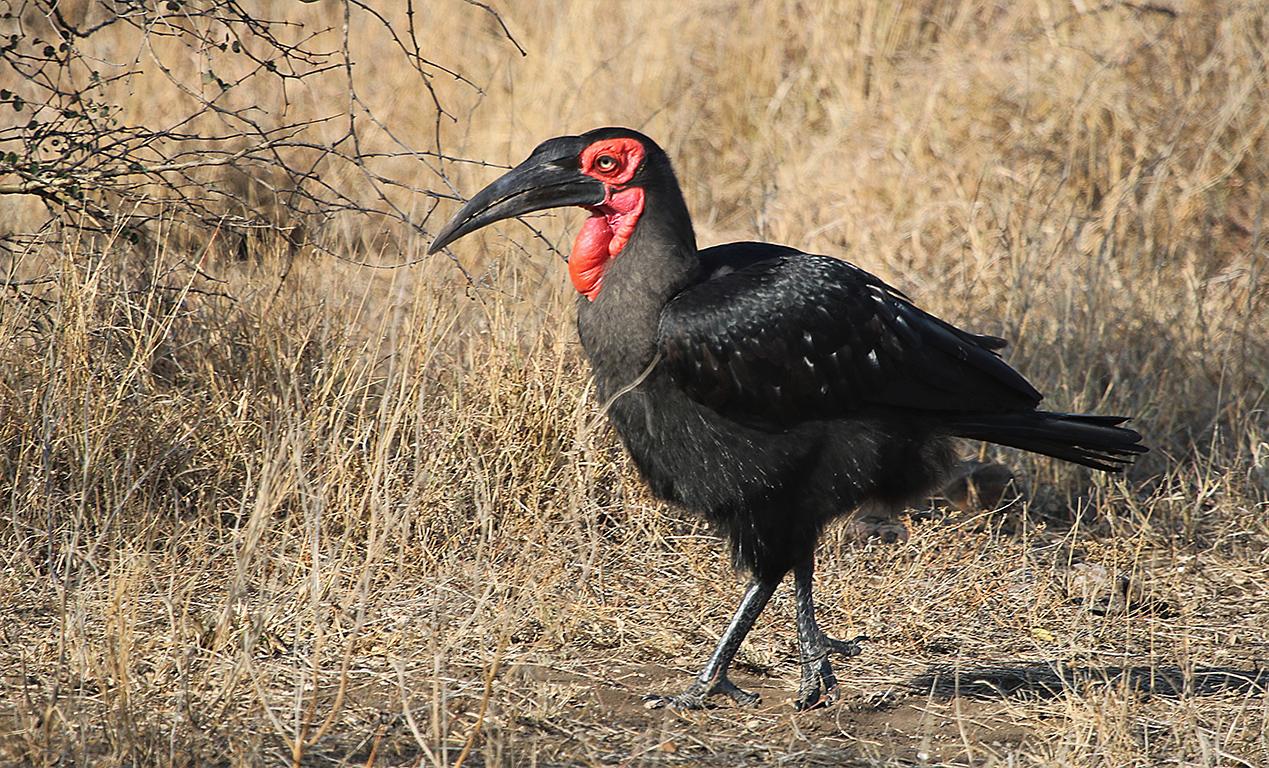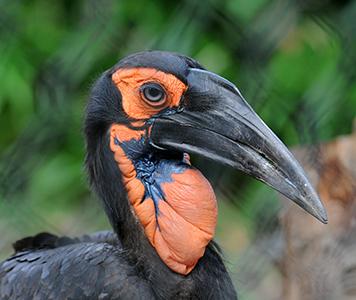Southern Ground Hornbill (male)

Kruger, South Africa
The scarce, iconic southern ground hornbill is found from Kenya to South Africa.
Habitat
The southern ground hormbill inhabits woodlands and savanna, where they require short grass for foraging and large trees for nesting.
Feeding
Ground hornbills are carnivores and terrestrial hunters of insects, snails, reptiles, amphibians and small mammals up to the size of hares.
Breeding
Their nests are often found in hollows in old trees or occasionally in shallow cavities in cliff faces. The southern ground hornbill breeding pair are always assisted by at least two other birds. Unaided pairs are unable to successfully raise chicks. Thus the ground hornbill is a "obligate cooperative breeder" which is why in the wild, the observer always sees foraging groups of at least four birds. Research shows that ground hornbills who do not have at least six years experience as helpers, are unable to breed successfully themselves.
Breeding Challenges
A female lays one to three white, rough textured eggs but "siblicide" (killing brothers and sisters) ensures only one chick fledges. From the beginning of incubation to fledging is a period of 135 days with a further one to two years of dependency depending on weather conditions, the longest period for any bird. This means a very rare three year breeding cycle (triennial) which does not help the species' chances of survival. An additional obstacle to reproductive success is the fact it takes six or seven years for a bird to achieve sexual maturity but very few find a mate at this age as they need their long apprenticeship as helpers.
Wildfile Specials
- There are two species of ground hornbill. The other one is the Abysinnian ground hornbill, a close northern relative of the southern ground hornbill. The two species are the largest hornbills in the world.
- Ground hornbills live up to 70 years which is amongst the longest for any bird species.
- Southern ground hornbills very rarely drink.
- Males and females are distinguished by the red throat colour of the male in contrast to the female's deep violet blue.
- Bare skin on the faces and throats of southern ground hornbills is believed to keep dust out of their eyes while foraging in the dry season.
- In urban areas, southern ground hornbills have broken windows while attacking their own reflections.
- The southern ground hornbill is a vulnerable species and classified as endangered in South Africa and is now mainly found only in national parks and reserves. Threats to ground hornbills include their use in traditional medicines and the extent to which they are hunted for bush meat. They also require vast territories for foraging so habitat loss hits them hard. And don't forget their three year breeding cycle.
In Culture
- In some African cultures southern ground hornbllis are believed to bring misfortune, illness and death if approached too closely.
- The southern ground hornbill is associated with rain, drought, lightning and weather forecasting. The Ndebele of Zimbabwe believe that its early morning call is a sign of rain and the Amaxhosa of South Africa believe the southern ground hornbill can be used in witchcraft to bring rain and end droughts.
- Because the southern ground hornbill is such a successful forager, in Zimbabwe, Malawe and South Africa, there is a belief that people in close contact with the bird will be more able to find food.

Southern Ground Hornbill (female)